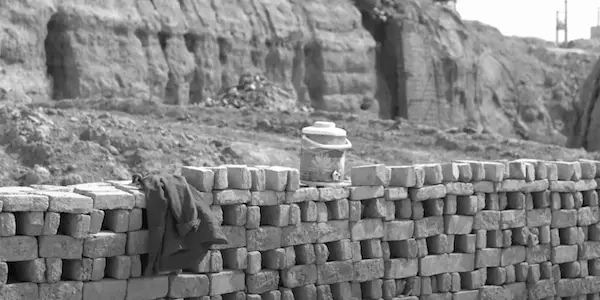The late Kiarostami’s protegé Ahmad Bahrami returns with The Wasteland (Dashte Khamoush), a moody drama following the plight of a bricklaying factory in the middle of Iranian desert backwater.

As part of the 77th Venice Film Festival’s Orrizonti lineup, and one of two films representing Iran at the festival, Bahrami’s second feature The Wasteland wrestles with similar themes of class and race. Unlike his teacher, Bahrami places a larger focus on the macabre — a palpable sense of spiritlessness riffs through the film. Shot in academy ratio by Masoud Amini Tirani, with a splash of gritty black-and-white grading against the backdrop of the sandy factory, the film follows Lotfollah (Ali Bagheri) the factory supervisor who goes to great lengths to protect Sarvar (Mahdieh Nassaj), the woman he secretly fancies.
DYNAMIC VISUALS BUT MONOTONOUS
Bahrami, who was born in 1970 before the onslaught of the Iranian revolution, follows more of a post-revolutionary tenor, as he whittles down the political to its most domestic unit. Bahrami’s tale is an homage to his father, a worker at an industrial factory himself.
There’s far less dreamlike philosophizing than what we would see in a Kiarostami film, none of the characters in ‘The Wasteland’ seem to have any room to think of anything other than work, as a socio-economic pall drapes over their lives. Instead of relying on Socratic conversation to carry the narrative, Bahrami’s cinematic lexicon focuses on stillness, weaving a loose narrative thread only through hushed conversations. In an almost monotonous roll of inertia, the first half of the film feels as if it’s unstuck in time, with many shots of the factory’s tasks repeating themselves and conversations often echoing one another.
Similar to Pawel Pawlikowski’s 2018 Academy Award-winning film Cold War, about two lovers divided by the iron curtain, the darkness of the frame in The Wasteland is the biggest cinematic pull, as it is relatively void of a soundtrack.
Linguistically, the film makes a point of showcasing the ethnic divide between the bricklayers as dialogue shifts from Farsi, to Turkish and Kurdish. This particular element is a driving force in the film, though it may feel like a less visible layer to speakers unfamiliar with any of the nuances of the languages. Aside from the visuals, the semantics are perhaps the most interesting element of the film.
CONCLUSION
Altogether, Bahrami strays away from the typical tropes of Iranian New Wave giving ‘The Wasteland’ an entirely new, bleaker feel. If anything, the blueprint of ‘The Wasteland’ is a universal one: the anxiety of work in tough times, and the linger of a love that never truly arrives.
Unfortunately, while ambitious, the film feels too much like a stiff piece of auteur art-cinema to fully throttle into an enticing narrative. Sequences are a little too displaced and contrived within the 35mm frame that it’s too cramped and slow-moving to trace any kind of affinity between the two protagonists. Still, Bahrami demonstrates technical skill and just may be one auteur to watch in the future of the Iranian Second Wave.
What do you think? Does Ahmad Bahrami have the potential to be the next Abbas Kiarostami? Let us know in the comments below.
https://www.youtube.com/watch?v=oUyvj13a0zE
Watch The Wasteland
Does content like this matter to you?
Become a Member and support film journalism. Unlock access to all of Film Inquiry`s great articles. Join a community of like-minded readers who are passionate about cinema - get access to our private members Network, give back to independent filmmakers, and more.